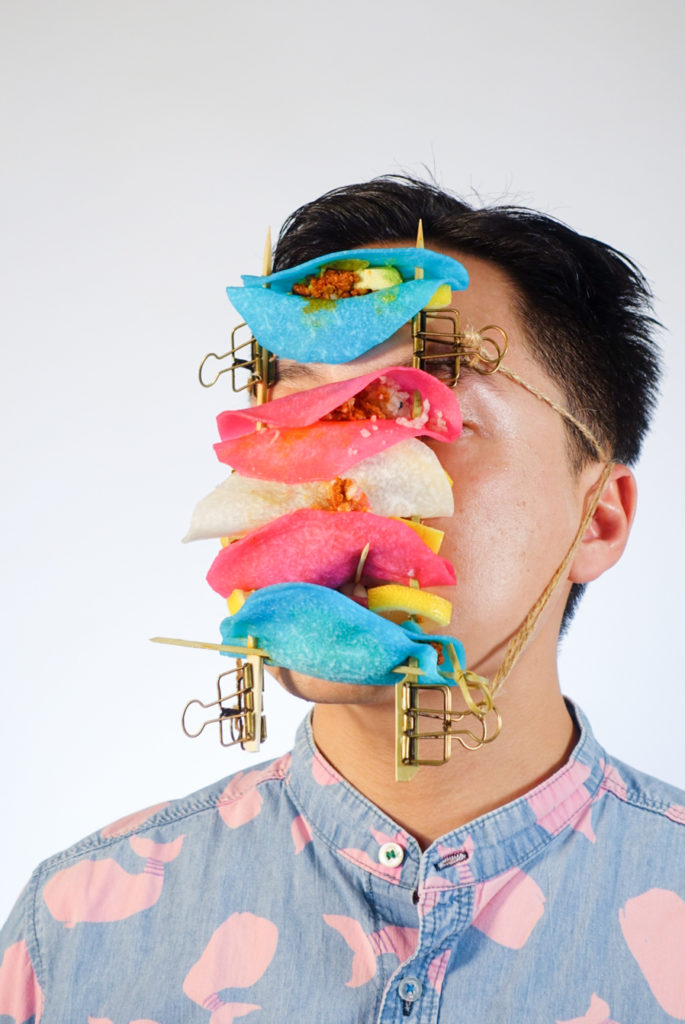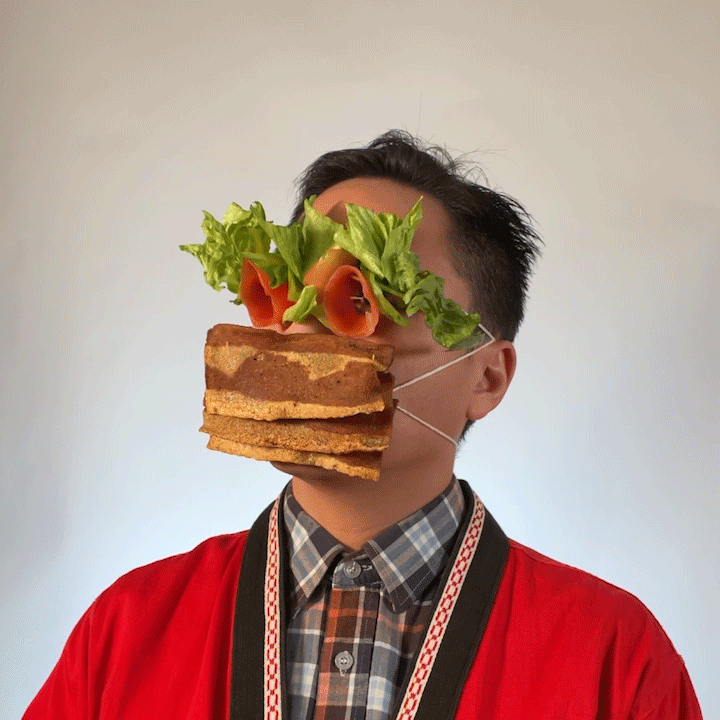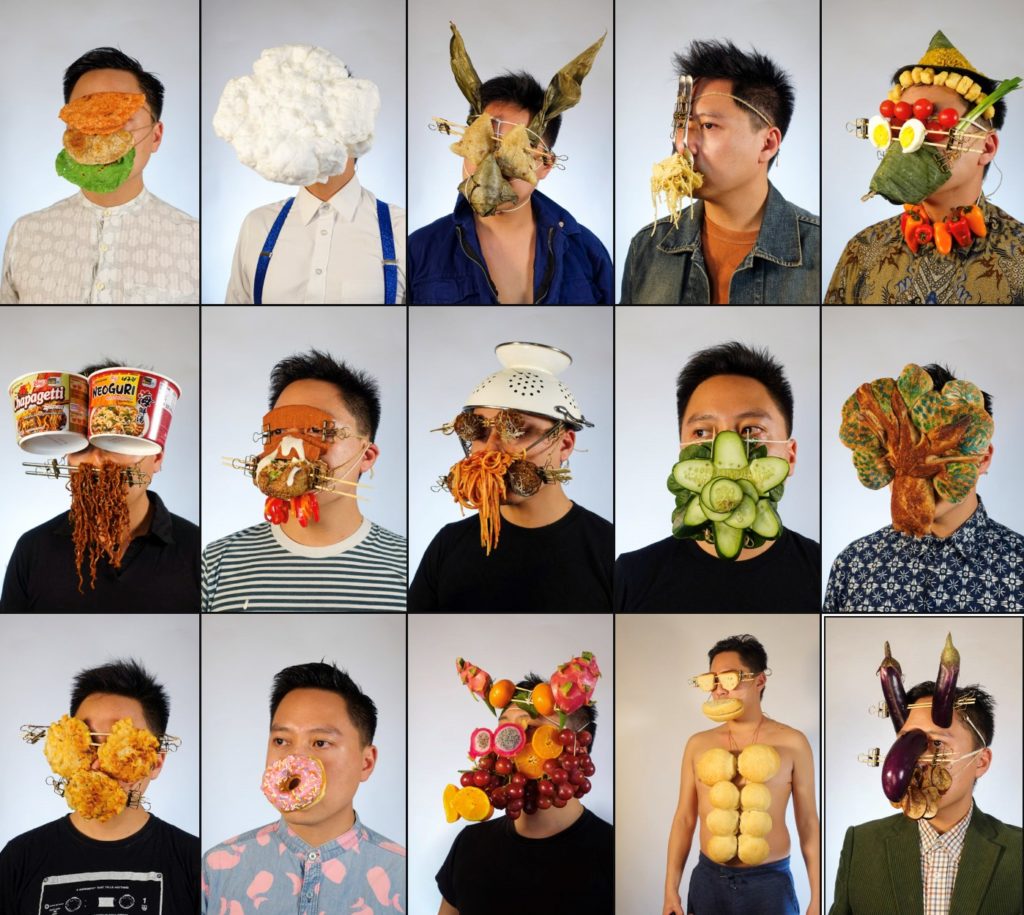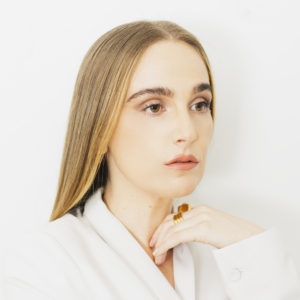Antonius Oki Wiriadjaja, also known as “FoodMasku,” is a multimedia artist based in New York City. Originally from Jakarta, Antonius is a former Fulbright U.S. Scholar in Indonesia. He created the Instagram account @foodmasku — depicting face masks made from meals eaten during COVID-19 self-isolation — after seeing a fellow artist wear a pickle face filter during a zoom meeting. In response, he placed kale on his face and started posting food face-mask selfies daily. As a result, his project was selected by The New York Times as one of “five art accounts to follow on Instagram now.” In addition, Antonius has recently premiered his new series, the Hundred Day Mask Challenge, exclusively with KnownOrigin.
As a performance artist, did you always have a penchant for being “on stage,” or was this an interest that developed later? What was your experience growing up? Were you a creative child? Did you want to be an artist?
In my late teens, I worked with the Theater Offensive in Boston and was working behind the scenes. There were some performances that needed extras, so I ended up going on stage anyway. The friendships I developed there blossomed, and many of my friends became amazing drag performers. At least two of them have been on Ru Paul’s Drag Race, and I’m super proud of their success! One year, there was a big contest, and all my friends had won at least once. So they all were bragging and heckling me because I had never done it. I said, screw it, I bet I could win this too. And I did! I was a real hot mess. My make-up was all cakey, and I took my wig from the trash of Jacque’s Cabaret. But the community wanted to be supportive, so I won $100 on a drag contest I didn’t even have any right to be a part of. They weren’t so forgiving the next time I went on stage! The heckling was huge, but it was important critical feedback, and I got better and better at stage presence. I stopped doing drag when I moved to New York, but those skills never left.

Who is FoodMasku? Tell me about the genesis of the FoodMasku identity and where the concept for the work originated.
FoodMasku is a pun in two languages. In English, it’s food + mask + u, and in Bahasa Indonesia / Javanese, it could also mean “food of my brother.” It started in April of 2020. I was in New York and couldn’t return to Indonesia to finish a project I had started as a Fulbright Scholar. I was really depressed, but I kept busy sewing fabric masks with a PPE collective I had joined due to the shortage of masks in New York at the time. One night, during a zoom meeting, a colleague had left on a face filter that made her look like a pickle. In response, I put a piece of kale on my face like a mask. It was the first time I heard laughter in a month. After that, I started doing the masks every day and posting them on Instagram. People really enjoyed it, and it became a source of pure joy in an otherwise very difficult moment in my life. It exploded sometime in the fall when I had a video that hit millions of views, and I was selected as one of five art Instagram accounts to follow by the New York Times! I still can’t believe it happened.
When I look at your work, I can’t help but think about performance artists like Rirkrit Tiravanija, Janine Antoni, and Paul McCarthy, who all incorporated food into their performances. Do you feel aligned with these artists? Are there other contemporary artists (living or dead) that inspire your work or movements that you have drawn on?
I’m so glad you see those artists’ influence in my work! One big source of inspiration during this project is Melati Suryodarmo, the protégée of Marina Abramović. I had worked with Melati and Jessika Kenney, who did the voice work for the movie Midsommar, on a show in November 2019. Every time I visited Melati’s home, I would get fed! It was an important part of the day. Melati is well known for her Exegie – Butter Dance, where she wears high heels and dances to an Indonesian drum pattern on top of twenty slabs of butter until she runs out of energy, sometimes for hours. She does several endurance-based movement pieces like these, and it is why the act of making a mask every day was an important part of FoodMasku. Singularly, doing one of the masks isn’t enough. But repeating it like a ceremony was important.
I’m also feeling super giddy right now because the artists who I have looked up to are reaching out to me! Kevin Abosch collected my work and complimented me on Twitter recently. Karen Finley commented she liked my tribute to her honey piece on Instagram. And Jan Hakon Erichsen also congratulated me on my recent work. All in the past few days. What an honor!
There is a rich historical tradition with performance art. How do you see yourself and your work placed within that canon as an artist minting these works on the blockchain?
I first heard about NFTs in December of 2020 and read as much as I could about them. I wanted to mint my pieces on the blockchain as a way to claim ownership of them because people were saving my images and videos and reposting them across social media without my knowledge. The blockchain is important in that regard because the videos and photos were never what was important to me in performance. It was the concept of FoodMasku. In many ways, performance art fits perfectly on the blockchain because it is the token that is important and not necessarily the final outcome. It preserves a concept and the idea rather than the documentation of it.

Performance art is inherently political. As more artists such as yourself enter the NFT space, do you feel the landscape will broaden in terms of this genre of art being viewed and appreciated for its message rather than its aesthetics?
Yes! I can’t wait. FoodMasku is quite wholesome compared to the rest of my body of work. But it was the right project at the right time, and I have to thank Taylor.wtf for making sure I was getting recognized for it. He’s a great example of someone pushing boundaries of what is considered art in the NFT space. Some people dismiss his burning of the ape as an attention-seeking marketing ploy. But I saw it as a performance piece. It was definitely controversial. I can’t wait until more challenging and more political works enter the NFT space. It will for sure be difficult. But like how I couldn’t become the artist I am today without dozens of queer kids heckling me in a drag show, we won’t become better artists without critical feedback and debate in the NFT space.
Tell me more about the genesis of Hundred Day Mask Challenge. What sparked the series, how is the journey, and where do you see it going after it’s over. What legacy do you hope to leave behind with this series?
It started in sadness and fear. I was really appalled by the insurrectionists attempting to overthrow congress on January 6, 2021. I started to develop ideas for the series of a hundred masks for the first hundred days of the new administration. At first, it was an attempt to remain positive and connect the 50 states together with local delicacies. But then things got more heated in the USA. Simply wearing an N95 mask became a political act. I wanted to tap into that. The new administration didn’t make an explicit mask mandate but created a “Hundred-day mask challenge,” and I decided to appropriate the hashtag. There were definitely many people who were confused. It was open to interpretation. Some thought I was making fun of people who wore face masks. Some thought I was just trying to get a Tik Tok challenge going and even joined in. But no matter what, people were mostly positive about the idea! I hope, when I’m gone and the blockchain is still here, preserving my masks, people see this as a snapshot of that time in our lives when our ideologies split us apart, but we all found humor in the same thing.
After the Hundred Day Mask Challenge series comes to a close, what will you be working on next?
I am working on a generative project with a team, and it has been a lot of fun. And I am also starting a new series called Season’s Eatings which looks at the food we eat and create for festivities and holidays. NFT NYC is coming up as well, and I really should be preparing my talk! I can’t wait to meet all the people visiting the city just for NFTs.
To learn more about Antonius, check out all his NFTs on Opensea, visit his website, and follow him online:
Instagram: @foodmasku
Twitter: @foodmasku
Website: http://work.antoni.us/




